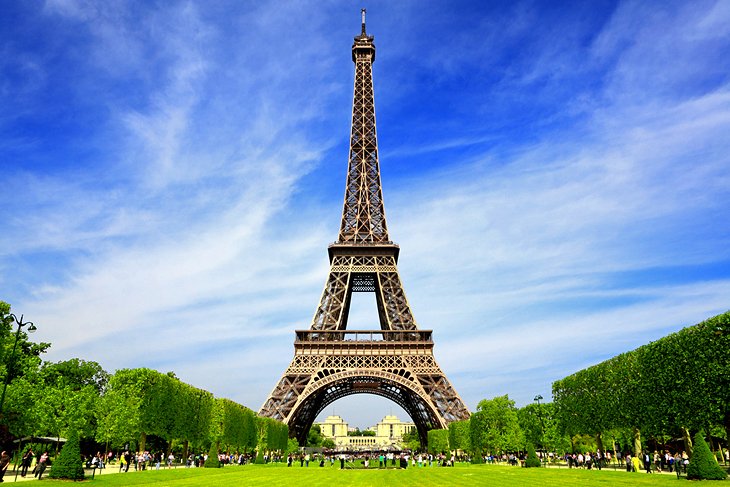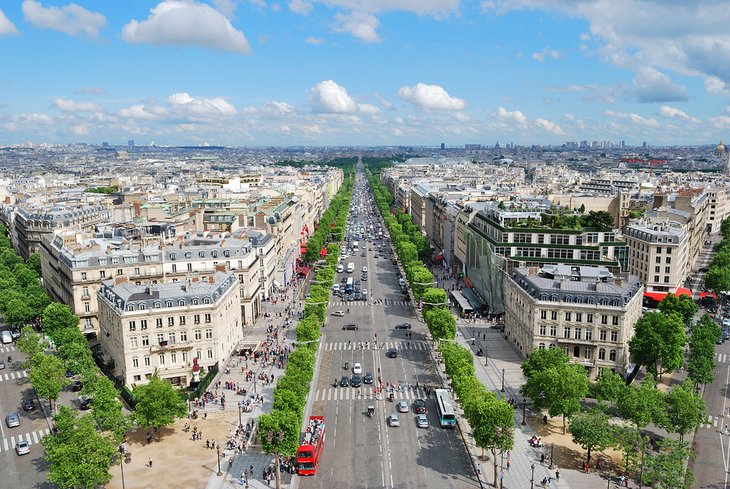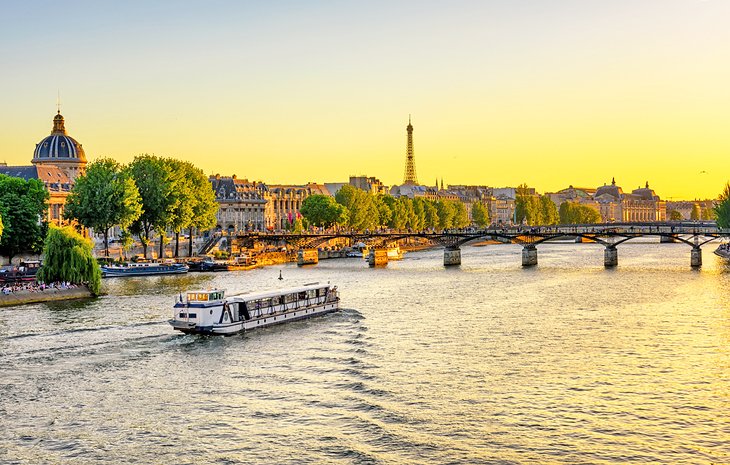Paris France’s capital, is a major European city and a global center for art, fashion, gastronomy and culture. Its 19th-century cityscape is crisscrossed by wide boulevards and the River Seine. Beyond such landmarks as the Eiffel Tower and the 12th-century, Gothic Notre-Dame cathedral, the city is known for its cafe culture and designer boutiques along the Rue du Faubourg Saint-Honoré.
Paris is a major railway, highway, and air-transport hub served by two international airports: Paris–Charles de Gaulle (the second-busiest airport in Europe) and Paris–Orly. Opened in 1900, the city’s subway system, the Paris Métro, serves 5.23 million passengers daily; it is the second-busiest metro system in Europe after the Moscow Metro. Gare du Nord is the 24th-busiest railway station in the world and the busiest located outside Japan, with 262 million passengers in 2015. Paris is especially known for its museums and architectural landmarks: the Louvre received 2.8 million visitors in 2021, despite the long museum closings caused by the COVID-19 virus. The Musée d’Orsay, Musée Marmottan Monet and Musée de l’Orangerie are noted for their collections of French Impressionist art. The Pompidou Centre Musée National d’Art Moderne has the largest collection of modern and contemporary art in Europe and Musée Rodin and Musée Picasso. The historical district along the Seine in the city centre has been classified as a UNESCO World Heritage Site since 1991; popular landmarks there include the Cathedral of Notre Dame de Paris on the Île de la Cité, now closed for renovation after the 15 April 2019 fire. Other popular tourist sites include the Gothic royal chapel of Sainte-Chapelle, also on the Île de la Cité; the Eiffel Tower, constructed for the Paris Universal Exposition of 1889; the Grand Palais and Petit Palais, built for the Paris Universal Exposition of 1900; the Arc de Triomphe on the Champs-Élysées, and the hill of Montmartre with its artistic history and its Basilica of Sacré-Coeur.
1.Eiffel Tower

Locally nicknamed “La dame de fer” (French for “Iron Lady”), it was constructed from 1887 to 1889 as the centerpiece of the 1889 World’s Fair. Although initially criticised by some of France’s leading artists and intellectuals for its design, it has since become a global cultural icon of France and one of the most recognisable structures in the world. The Eiffel Tower is the most visited monument with an entrance fee in the world: 6.91 million people ascended it in 2015. It was designated a monument historique in 1964, and was named part of a UNESCO World Heritage Site (“Paris, Banks of the Seine”) in 1991.
The tower is 330 metres (1,083 ft) tall, about the same height as an 81-storey building, and the tallest structure in Paris. Its base is square, measuring 125 metres (410 ft) on each side. During its construction, the Eiffel Tower surpassed the Washington Monument to become the tallest human-made structure in the world, a title it held for 41 years until the Chrysler Building in New York City was finished in 1930. It was the first structure in the world to surpass both the 200-metre and 300-metre mark in height. Due to the addition of a broadcasting aerial at the top of the tower in 1957, it is now taller than the Chrysler Building by 5.2 metres (17 ft). Excluding transmitters, the Eiffel Tower is the second tallest free-standing structure in France after the Millau Viaduct.
2.Musée du Louvre

The Louvre, or the Louvre Museum, is the world’s most-visited museum, and an historic landmark in Paris, France. It is the home of some of the best-known works of art, including the Mona Lisa and the Venus de Milo.
Musée du LouvreA sumptuous palace that was once the home of France’s kings, the Louvre is the most important of Paris’ top museums. Visitors enter the museum in the courtyard of the palace at the Pyramid du Louvre, the glass pyramid designed by Ieoh Ming Pei in 1917. The Musée du Louvre displays thousands of artworks, many of which are considered masterpieces, from antiquities to European paintings of the 15th to 19th centuries.
It is impossible to see it all in one visit, but tourists can focus on a particular gallery, such as classical sculpture, Italian Renaissance art, or 17th-century French paintings, or take a self-guided tour to cover the Louvre Museum’s highlights.
Le Louvre possède une longue histoire de conservation artistique et historique, depuis l’Ancien Régime jusqu’à nos jours. À la suite du départ de Louis XIV pour le château de Versailles à la fin du XVIIe siècle, on y entrepose une partie des collections royales de tableaux et de sculptures antiques. Après avoir durant un siècle hébergé plusieurs académies dont celle de peinture et de sculpture, ainsi que divers artistes logés par le roi, l’ancien palais royal est véritablement transformé sous la Révolution en « Muséum central des arts de la République ». Il ouvre en 1793 en exposant environ 660 œuvres, essentiellement issues des collections royales ou confisquées chez des nobles émigrés ou dans des églises. Par la suite les collections ne cesseront de s’enrichir par des prises de guerre, acquisitions, mécénats, legs, donations, et découvertes archéologiques.
Le musée compte pour sa gestion 2 091 employés (fonctionnaires, contractuels et vacataires), dont 1 232 agents de surveillance, un garde pour chacune des 403 salles d’exposition, que complètent les effectifs affectés aux 900 caméras du système de télésurveillance.
3.Cathédrale Notre-Dame de Paris

Notre-Dame de Paris, referred to simply as Notre-Dame, is a medieval Catholic cathedral on the Île de la Cité, in the 4th arrondissement of Paris. The cathedral, dedicated to the Virgin Mary, is considered one of the finest examples of French Gothic architecture.
Notre-Dame stands in the heart of Paris on the Île-de-la-Cité next to the Latin Quarter. An island in the Seine River, the Île-de-la-Cité is the historical and geographical center of Paris. On this small plot of land, the Romans built the Gallo-Roman city of Lutetia, and from the 6th century to the 14th century, the Kings of France resided here.
The Cathédrale Notre-Dame de Paris was founded in 1163 by King Louis IX (Saint Louis) and Bishop Maurice de Sully, and the construction took more than 150 years. The cathedral was first created in Early Gothic style, while later additions (the west front and the nave) show the transition to High Gothic style.
This impressive medieval monument is a triumph of Gothic architecture. The ornately decorated facade creates a breathtaking impression with its profusion of sculptures and gargoyles, while elaborate flying buttresses provide structural integrity for the enormous building.
Construction of the cathedral began in 1163 under Bishop Maurice de Sully and was largely completed by 1260, though it was modified frequently in the centuries that followed. In the 1790s, during the French Revolution, Notre-Dame suffered extensive desecration; much of its religious imagery was damaged or destroyed. In the 19th century, the coronation of Napoleon I and the funerals of many of the French Republic’s presidents took place at the cathedral.
The 1831 publication of Victor Hugo’s novel Notre-Dame de Paris (known in English as The Hunchback of Notre-Dame) inspired popular interest in the cathedral, which led to a major restoration project between 1844 and 1864, supervised by Eugène Viollet-le-Duc. On August 26, 1944, the Liberation of Paris from German occupation was celebrated in Notre-Dame with the singing of the Magnificat. Beginning in 1963, the cathedral’s façade was cleaned of centuries of soot and grime. Another cleaning and restoration project was carried out between 1991 and 2000.
4.Avenue des Champs-Élysées

The Avenue des Champs-Élysées is an avenue in the 8th arrondissement of Paris, France, 1.9 kilometres long and 70 metres wide, running between the Place de la Concorde in the east and the Place Charles de Gaulle in the west, where the Arc de Triomphe is located.
The most monumental boulevard in Paris used to be a desolate field of marshland until the 17th century, when it was landscaped by André Le Nôtre. A century later, the Parisian city planner Baron Haussmann designed the boulevard’s elegant buildings.
The Champs-Élysées is divided into two parts with the Rond-Point des Champs-Élysées as its intersection.
The lower part of the Champs-Élysées, bordering the Place de la Concorde, includes a spacious park, the Jardins des Champs-Élysées, and the Petit Palais fine arts museum. The upper part, extending to the Arc de Triomphe, is lined by luxury shops, hotels, restaurants, cafés, cinemas, and theaters. This bustling area draws many tourists and is a gathering place for Parisians.
De avenue is 1910 meter lang, en loopt door het 8e arrondissement in het noordwesten van Parijs, vanaf de Place de la Concorde met de bekende obelisk in het oosten tot aan de Place Charles de Gaulle (de voormalige Place de l’Étoile) met de Arc de Triomphe in het westen. De Champs-Élysées maakt deel uit van de Axe historique. De oostzijde van de trekpleister wordt begrensd door volle groene bomen en gebouwen als het Théâtre Marigny en het Grand Palais (met daarbinnen het Palais de la Découverte). Het Élysée ligt iets noordelijker, niet aan de avenue zelf. Verder naar het westen ligt de nadruk op bioscopen, theaters, cafés en restaurants (waarvan Fouquet’s het bekendste is).
Trekt men de laan verder door, dan vindt men in het oosten de Place de la Concorde, de Jardin des Tuileries, de Place du Carrousel (waar een kleine triomfboog staat, de Arc de Triomphe du Carrousel) en het Louvre. Aan de westkant zet de laan zich voort via de Place Charles de Gaulle (met de grote Arc de Triomphe), de Avenue de la Grande Armée, de Porte Maillot, de Avenue Charles de Gaulle, en op de linkeroever, in de wijk La Défense, de Esplanade du Général de Gaulle met de moderne Grande Arche. Het geheel is bijna 2 km lang.
5.Musée d’Orsay

The Musée d’Orsay is a museum in Paris, France, on the Left Bank of the Seine. It is housed in the former Gare d’Orsay, a Beaux-Arts railway station built between 1898 and 1900. The museum holds mainly French art dating from 1848 to 1914, including paintings, sculptures, furniture, and photography.
The Musée d’Orsay displays a splendid collection of 19th- and 20th-century art (created from 1848 to 1914) in the converted Gare d’Orsay. This Belle Epoque railway station was built for the Universal Exhibition of 1900.
Some of the world’s most cherished paintings are on display in the museum’s spacious galleries. The Orsay Museum is among the best places to visit in Paris to get an overview of Impressionist art history. Visitors are delighted by the broad assortment of paintings, from canvases that reveal the gentle pastel-hued brush strokes of Monet to the wild, colorful scenes of Gauguin.
Situé dans le 7e arrondissement de Paris le long de la rive gauche de la Seine, en surplomb de la promenade Édouard-Glissant, il est installé dans l’ancienne gare d’Orsay, construite par Victor Laloux de 1898 à 1900 et réaménagée en musée sur décision du président de la République Valéry Giscard d’Estaing. Ses collections présentent l’art occidental de 1848 à 1914, dans toute sa diversité : peinture, sculpture, arts décoratifs, art graphique, photographie, architecture, etc. Il est l’un des plus grands musées d’Europe pour cette période.
Le musée possède la plus importante collection de peintures impressionnistes et postimpressionnistes au monde, avec près de 1 100 toiles3 au total sur plus de 3 650 en sa possession. Le public peut y voir des chefs-d’œuvre de la peinture et de la sculpture comme Le Déjeuner sur l’herbe et l’Olympia d’Édouard Manet, une épreuve de La Petite Danseuse de quatorze ans de Degas, L’Origine du monde, Un enterrement à Ornans, L’Atelier du peintre de Courbet, Les Joueurs de cartes de Cézanne ou encore cinq tableaux de la Série des Cathédrales de Rouen de Monet et Bal du moulin de la Galette de Renoir.
Des expositions temporaires monographiques ou thématiques concernant périodiquement l’œuvre d’un artiste, un courant ou une question d’histoire de l’art sont souvent mises en place. Un auditorium accueille des manifestations diversifiées, concerts, cinéma, théâtre d’ombres, conférences et colloques et des spectacles spécifiquement destinés à un jeune public.
6.Arc de Triomphe

The Arc de Triomphe de l’Étoile is one of the most famous monuments in Paris, France, standing at the western end of the Champs-Élysées at the centre of Place Charles de Gaulle, formerly named Place de l’Étoile—the étoile or “star” of the juncture formed by its twelve radiating avenues.
The Arc de Triomphe is dedicated to the soldiers who fought in the French armies of the Revolution and the First Empire (Napoleonic Wars). Napoleon commissioned the building of this mighty structure in 1806 but did not live to see its completion in 1836.
Designed by architect Jean-François Chalgrin, who modeled the monument after the Arch of Titus in Rome, the massive 50-meter-high arch features bas-reliefs with larger-than-life-size figures, which depict the departure, victories, and glorious return of the French armies.
De bouw begon in 1806, ter ere van Napoleons overwinning bij Austerlitz. Pas rond 1836, onder koning Lodewijk Filips, werd de bouw voltooid. Onder de Arc de Triomphe werd na de Eerste Wereldoorlog het Graf van de onbekende soldaat aangelegd, die in die oorlog was gesneuveld. De Arc de Triomphe is veranderd in een monument ter nagedachtenis van de Eerste Wereldoorlog.
De triomfboog is ongeveer 50 m hoog en heeft een basis van 45 m bij 22 m. Het is de op twee na grootste triomfboog in de wereld, na die van Pyongyang in Noord-Korea en na het Monument voor de Revolutie in Mexico-Stad.
7.Seine River Cruises

There are 37 bridges in Paris across the Seine (the most famous of which are the Pont Alexandre III and the Pont Neuf) and dozens more outside the city. A notable bridge, which is also the last along the course of the river, is the Pont de Normandie, the ninth longest cable-stayed bridge in the world, which links Le Havre and Honfleur.
The Seine is a 777-kilometre-long river in northern France. Its drainage basin is in the Paris Basin covering most of northern France. It rises at Source-Seine, 30 kilometres northwest of Dijon in northeastern France in the Langres plateau, flowing through Paris and into the English Channel at Le Havre.
A boat cruise along the Seine River is one of the best ways to soak up the alluring scenery of Paris. Seine River Cruises allow tourists to see the sights from a different perspective. The Seine River bridges, Eiffel Tower, Notre-Dame Cathedral, and the Louvre Museum look stunning from the viewpoint of a riverboat.
While a daytime cruise allows tourists to appreciate the glory of the monuments brightened by sunshine, the most romantic experience is an evening cruise. After sunset, the city’s landmarks are illuminated, which creates a special effect, and somehow the city seems more magical.
For a cruise that includes dinner, try the Bateaux Parisiens Seine River Gourmet Dinner & Sightseeing Cruise. This luxurious riverboat cruise departs at the Port de la Bourdonnais (near the Eiffel Tower), and guests are treated to a gourmet three-course meal.









